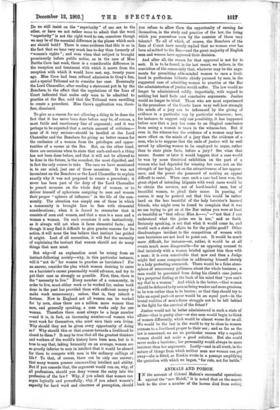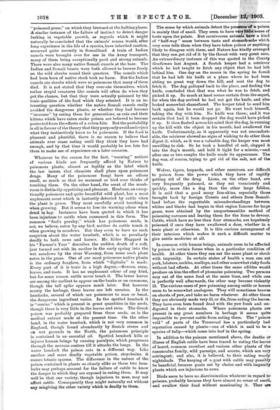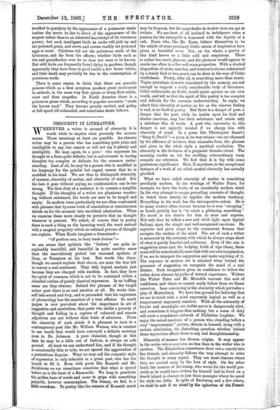ANIMALS AND POISON.
N the account of Colonel Mahon's successful operations against the "new Mahdi," it is noted that on the march back to the river a number of the horses died from eating "poisoned grass," on which they browsed at the halting places. A similar instance of the failure of instinct to detect danger lurking in vegetable growth, as regards which it might naturally be concluded that the animals' senses would, after long experience in the life of a species, have inherited caution, occurred quite recently in Somaliland. A train of Indian camels were brought over for use in the Army transport., many of them being exceptionally good and strong animals. There were also many native Somali camels at the base. The Indian and Somali beasts were both allowed to browse freely on the wild shrubs round their quarters. The camels which had been born of native stock took no harm. But the Indian camels ate shrubs which were so poisonous that many of them died. It is not stated that they over-ate themselves, which rather stupid creatures like camels will often do when they get the chance, but that they were actually poisoned by the toxic qualities of the food which they selected. It is an in- teresting question whether the native Somali camels really avoided the dangerous plants, or whether they had become " immune " by eating them for generations, as cats and their kittens which have eaten snake poison are believed to become protected from the effects of a cobra-bite. But the probability is all in favour of the theory that they purposely avoid and reject what they instinctively know to be poisonous. If the food is pleasant and plentiful, there is no reason to believe that animals ever cease eating until they think they have had enough, and by that time it would probably be too late for them to make use of experience on a later occasion.
Whatever be the reason for the fact, "warning" notices of various kinds are frequently affixed by Nature to poisonous plants, almost as legibly as the label which the law insists that chemists shall place upon poisonous drugs. Many of the poisonous fungi have an odious smell, so much so that no mammal or bird ever thinks of touching them. On the other hand, the scent of the mush- room is distinctly appetising and pleasant. Henbane, an excep- tionally poisonous and quite beautiful wild plant, has a most unpleasant scent which is instantly detected by cattle when the plant is green. They most carefully avoid touching it when growing. But it seems to lose its warning odour when dried in hay. Instances have been quoted in which it has been injurious to cattle when consumed in this form. The common "fool's parsley," which has poisonous seeds, is not, we believe, eaten by any bird, neither do cattle touch it when growing in meadows. But they seem to have no such suspicion about the water hemlock, which is so peculiarly deadly to both cows and horses. Mr. Rider Haggard in his "Farmer's Year" describes the sudden death of a colt, just turned out with its mother in the early spring into the wet meadows by the river Waveney, from some such plant eaten in the grass. One of our most poisonous native plants is the ordinary foxglove, from which "digitalis" is made. Every part of it is toxic in a high degree,—flowers, stem, leaves, and roots. It has no unpleasant odour of any kind, but for some reason cattle never touch it. The lower leaves are among the earliest to appear on the banks or on commons, though the tall spike appears much later. But however scanty the herbage, these leaves are left uneaten. In the hemlocks, several of which are poisonous to man or beast, the dangerous ingredient varies. In the spotted hemlock it is " conine " which is present in great quantities in the seeds, though there is very little in the leaves and stem. The Greek poison was probably prepared from these seeds, as is the medical extract made at the present time. On the other hand, in the water hemlock, which is not very common in England, though found abundantly by Scotch rivers and on wet grounds in the North, the poisonous principle is contained in an essential oil. Spotted hemlock kills or injures human beings by causing paralysis, which progresses through the nervous centres till it attacks the lungs. In the water hemlock the poison acts in a different way. Like another and more deadly vegetable poison, strychnine, it causes tetanic spasms. The difference in the nature of the poison contained in plants so closely alike as these two hem- locks may perhaps account for the failure of cattle to know, the danger to which they are exposed in eating them. It may well be that one variety, though injurious to man, may not affect cattle. Consequently they might naturally eat without any misgiving the other variety whioh is deadly to them. The sense by which animals detect the presence of a poison is mainly that of smell. They seem to have very little sense of taste upon the palate. But carnivorous animals have a kind of "half-way" sense between taste and stomach-ache which very soon tells them when they have taken poison or anything likely to disagree with them, and Nature has kindly arranged that they can get rid of it by the throat with very great ease. An extraordinary instance of this was quoted in the County Gentleman last August. A Scotch keeper had a retriever which he had taught to fetch any object that he had left behind him. One day on the moors in the spring he found that he had left his knife at a place where he had been sitting no great way down the hill, and sent the dog to fetch it. The dog galloped back to the place, and finding the knife, concluded that that was what he was to fetch, and picked it up. So much at least seems certain from the sequel, for when the dog arrived he had not got the knife, and also looked somewhat shamefaced. The keeper tried to send him back again, but he would not go. He went back himself, taking the dog with him. No knife was there; and it was certain that had it been dropped the dog would have picked it up. It then flashed across his mind that the dog, in running up the hill with the object in his mouth, had swallowed the knife. Unfortunately, as it apparently was not uncomfort- able, the retriever showed no signs of wishing to do other than digest it, which, as it was a valuable dog, the keeper was most unwilling to risk. So he took a handful of salt, clapped it into the dog's mouth, and held it tight for a minute,—and after one or two coughs the knife made its appearance. The dog was, of course, trying to get rid of the salt, not of the knife.
Wolves, tigers, leopards, and other carnivora are difficult to poison from the power which they have of rapidly getting rid of the drug. Lions, on the other hand, are very frequently poisoned, as they eat voraciously and quickly, more like a dog than the other large felidae. It is said that a good many lion-skins, especially those brought back by foreign Counts and others from Somali- land before the regrettable misunderstandings between whites and blacks had begun in that region famous for large game, were obtained by the unsportsmanlike method of poisoning carcases and leaving them for the lions to devour. Cattle, which have no less than four stomachs, are hopelessly poisoned if once they have swallowed a dose, whether in a toxic plant or otherwise. It is this curious arrangement of their interiors which makes it such a difficult matter to give cattle medicine at all.
In common with human beings, animals seem to be affected by poison in certain forms when in a particular condition of health. At other times they can eat the same plant or shrub with impunity. In certain states of health a man can eat pork, lobsters, cockles, scallops, and other somewhat risky foods without bad effects. At other times the same edibles would produce on him the effect of ptomaine poisoning. Two persons may eat of the same food at the same time, and while one is perfectly well afterwards, the other may become violently ill. The curious cases of yew poisoning among cattle or hors& seem to be somewhat analogous. They will sometimes browse on shoots of yew, and take no harm whatever. At other times they are obviously made very ill, or die, from eating the leaves. They have even been found dead with the yew fresh and un- digested in their stomachs. Where poisonous plants are present in any great numbers in herbage it seems quite impossible to prevent cattle from eating them. The "poison veld" of parts of the Transvaal has a particularly bad reputation caused by plants—one of which is said to be a species of tulip—which come into leaf in the spring.
In addition to the poisons mentioned above, the deaths or illness of English cattle have been traced to eating the leaves of laurel, common crowfoot and various other plants of the ranunculus family, wild parsnips, and acorns, which are veil astringent; and also, it is believed, to their eating woody nightshade. The keeping of a goat with cattle may possibly be beneficial, because goats eat by choice and with impunity plants which are injurious to cows.
Birds seem to have no discrimination whatever in regard to poisons, probably because they have almost no sense of smell, and swallow. their food without masticating it., They go terrified to paralysis by the appearance of a poisonous snake (unless the terror be due to dread of the appearance of the serpent rather than to an inherited knowledge of its venomous power); but such intelligent birds as rooks will pick up and eat poisoned grain, and crows and ravens readily eat poisoned eggs or meat. Chickens will eat the poisonous seeds of the laburnum, and die from the effects; whether birds such as tits and greenfinches ever do so does not seem to be known. But wild birds are frequently found dying in gardens, though apparently they have been in good health a few hours before, and their death may probably be due to' the consumption of poisonous seeds.
There is some reason to think that there are narcotic poisons which as a first symptom produce great excitement in animals, in the same way that opium or hemp first exhila- rates and then stupefies. In North America there is a poisonous grass which, according to popular accounts, "sends the horses mad." They become greatly excited, and gallop at full speed till exhausted, and sometimes death follows.




























































 Previous page
Previous page